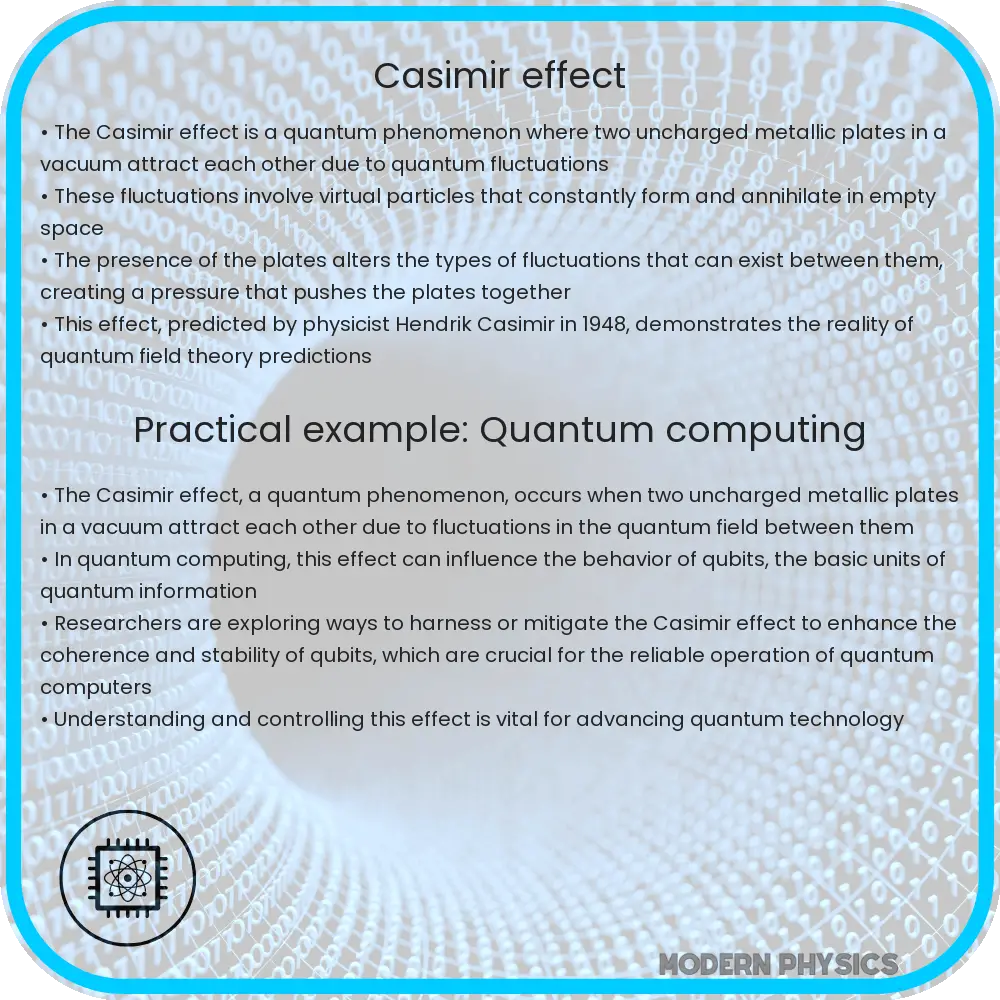The Casimir Effect is a quantum phenomenon where two uncharged plates in a vacuum attract due to vacuum fluctuations of the electromagnetic field.

Understanding the Casimir Effect
The Casimir Effect is a quantum mechanical phenomenon that arises from the vacuum fluctuations in the electromagnetic field. Discovered by the Dutch physicist Hendrik Casimir in 1948, this effect showcases one of the striking examples of the tangible consequences of quantum mechanics in the macroscopic world. In essence, the Casimir Effect can be observed when two uncharged, parallel plates in a vacuum are brought extremely close to each other. Unexpectedly, a force of attraction arises between them due purely to the quantum fluctuations of the vacuum.
How the Casimir Effect Works
In the vacuum of space, what is expected to be ‘nothing’ is actually a boiling sea of transient particles and antiparticles spontaneously appearing and annihilating. These virtual particles generate fluctuating electromagnetic waves. Typically, these waves are unrestricted in free space. However, when two conducting plates are placed close together in a vacuum, only certain wavelengths of the electromagnetic fluctuations are permitted between the plates due to boundary conditions set by the plates themselves.
The key to understanding the Casimir Effect lies in the contrasting conditions inside and outside the plates. Outside the plates, virtual particles of all possible wavelengths proliferate. Inside, the wavelengths are restricted to those that fit perfectly between the plates. The most common analogy is to think of the plates like guides for the waves, which can be compared to standing waves on a string that can only oscillate at certain frequencies. This restriction results in fewer types of waves existing between the plates than outside, leading to a lower pressure between the plates compared to the outer side.
This difference in pressure manifests as a force drawing the two plates together. This force, known as the Casimir force, can be calculated using the following formula:
\[ F_c = \frac{\pi^2 \hbar c}{240 a^3} \]
where \( F_c \) is the Casimir force per unit area, \( \hbar \) is reduced Planck’s constant, \( c \) is the speed of light, and \( a \) is the separation between the plates.
Experimental Validation and Challenges
The experimental confirmation of the Casimir Effect solidified it as a significant prediction of quantum field theory. Measuring the Casimir force requires precise instrumentation due to the extremely small scale at which it operates—usually forces are measurable only when the plates are less than a micron apart. Initial experiments in the late 20th century struggled with issues such as maintaining the perfect parallel alignment of the plates and accounting for other physical forces that could impact measurements, like electrostatic forces and surface roughness.
With advancements in technology, particularly in the fields of microfabrication and nanotechnology, more accurate measurements have been possible. Researchers have utilized techniques such as atomic force microscopy to observe the Casimir force with great precision. These experiments not only confirm the existence of the Casimir effect but also help refine the theoretical models that describe it.
Applications of the Casimir Effect
The Casimir Effect, while primarily of interest in theoretical physics, also holds potential for practical applications, particularly in the realm of nanotechnology. One of the most intriguing possibilities is the development of frictionless nanoscale machines. Since the Casimir force operates at such small scales, it could theoretically be harnessed to create devices where traditional frictional forces, which are a major challenge at the nanoscale, are negated. This could lead to significant advancements in the durability and efficiency of micro and nano devices.
Additionally, understanding and manipulating the Casimir force could lead to better control of microelectromechanical systems (MEMS). These systems are integral to various modern technologies, including accelerometers used in smartphones and other sensors. By fine-tuning the Casimir force, engineers could potentially design MEMS with enhanced performance or new functionalities.
Conclusion
The Casimir Effect is a fascinating phenomenon that not only challenges our understanding of the quantum world but also offers a glimpse into the tangible impacts of quantum mechanics on physical objects. Despite being a concept that originates from the theoretical framework of quantum field theory, the Casimir Effect has been experimentally validated and continues to inspire research in both foundational physics and applied technologies.
With ongoing advancements in measurement techniques and theoretical models, the full potential of the Casimir Effect is still being unraveled. Its implications in the fields of nanotechnology and microelectromechanical systems highlight the intertwining of pure science with engineering, showcasing how quantum mechanics can translate into practical applications. As research continues, the Casimir Effect may find its way into the design of future technologies, further blurring the lines between theoretical physics and engineering marvels.
